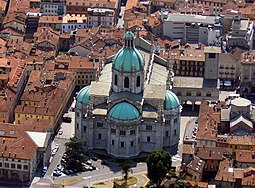Diocese of Como Dioecesis Comensis | |
|---|---|
 Aerial view of the cathedral in Como | |
| Location | |
| Country | Italy |
| Ecclesiastical province | Milan |
| Statistics | |
| Area | 4,244 km2 (1,639 sq mi) |
| Population - Total - Catholics | (as of 2021) 548,600 (est.) 529,890 (96.6%) |
| Parishes | 338 |
| Information | |
| Denomination | Catholic Church |
| Sui iuris church | Latin Church |
| Rite | Roman Rite |
| Established | 4th Century |
| Cathedral | Basilica Cattedrale di S. Maria Assunta |
| Secular priests | 330 (diocesan) 128 (Religious Orders) 13 Permanent Deacons |
| Current leadership | |
| Pope | Francis |
| Bishop | Oscar Cantoni |
| Bishops emeritus | Diego Coletti |
| Map | |
 | |
| Website | |
| Diocesi di Como (in Italian) | |
The Diocese of Como (Latin: Dioecesis Comensis) is a Latin Church ecclesiastical jurisdiction or diocese of the Catholic Church in northern Italy. It was established in the Fourth Century. It is a suffragan diocese in the ecclesiastical province of the metropolitan Archdiocese of Milan. The Bishop of Como's cathedra is in the Como Cathedral.[1]
Local legend credits the conversion of Como to the apostolate of Hermagoras of Aquileia (died c. 70).[2]
The diocese of Como was originally suffragan of Milan, as the consecration of its first bishop by Ambrose of Milan demonstrates.[3] By the mid 6th century the diocese was subject to Aquileia.[4] Pope Stephen V (885-891) twice ordered Patriarch Walpert of Aquileia to consecrate Liutard, the Bishop-elect of Como.[5] Until 1751 Como was, indeed, a suffragan of the patriarchate of Aquileia and followed the Aquileian Rite; the Patriarchate was suppressed by Pope Benedict XIV, who, on 18 April 1752, created the metropolitanate of Gorizia, and made Como subject to Goriza.[6] In 1789 Como was placed under the jurisdiction of the Archbishop of Milan by Pope Pius VI.[7]
- ^ David M. Cheney, Catholic-Hierarchy.org, "Diocese of Como"; retrieved February 29, 2016. [self-published source] Gabriel Chow, GCatholic.org, "Diocese of Como"; retrieved February 29, 2016. [self-published source]
- ^ The story is not creditable; see: Ughelli, V, pp. 256–257. Cantù, I, pp. 33–34.
- ^ Kehr, p. 399: "Comensis episcopi, qui primum Mediolanensi archiepiscopo, posthaec Aquileiensi patriarchae suffragati sunt, inde ab a. 1751, Benedicto XIV iubente, parent Mediolanensi.
- ^ Orsini, p. 4.
- ^ Kehr, pp. 399-400, nos. 3-4.
- ^ Ritzler-Sefrin, Hierarchia catholica VI, p. 175 note 1: "A. 1764, Civ. Comen. sita in prov Lombardiae inhabitatur a 10,000 circ. incolarum, sub dominio temporli caes. maest. reginae Hungariae; eccl. cathedr. sub invocatione Assumptionis B.M.V. suffrag. metrop. Goritien."
- ^ Gaetano Moroni, "Como," Dizionario di erudizione historico-ecclesiastica Vol. XV (Venezia: Tipografia Emiliana 1842), p. 94: "Divenne suffragnea del patriarcato di Aquileja; dipoi nel 1751 avendo Benedetto XIV soppresso il patriarcato, nell'anno seguente à 18 aprile eresse in metropoli Gorizia, cui sottopose il vescovo id Como per suffraganeo; ma il Pontifice Pio VI nel 1789 dichariò questa sede suffraganea della metropolitana di Milano." Cappelletti, XI, p. 406.